Pore Structure and Fractal Characteristics of Coal Rocks Under Variable Moisture Content Increment Cycles Using LF-NMR Techniques
Abstract
1. Introduction
2. Materials and Methods
2.1. Specimen Selection
2.2. Test Equipment and Specimen Pretreatment
2.3. NMR Principles and Procedure
2.4. Fractal Dimension Theory
3. Results and Analyses
3.1. T2 Spectral and Magnetic Resonance Imaging Evolution
3.2. Pore Size Distribution Measured by NMR
3.3. Quantitative Characterization of Pore Structure Parameters
3.4. T2 Cutoff Value and Fractal Dimension Features
3.5. Pore Damage of Dry–Wet Cycling
4. Discussion
4.1. Correlative Analysis of Porosity and Pore Structure
4.2. Damage Mechanisms of Dry–Wet Cycling on Coal Pores
4.3. Research Limitations and Prospects
5. Conclusions
Author Contributions
Funding
Data Availability Statement
Acknowledgments
Conflicts of Interest
References
- Liu, X.; Zeng, Y.; Wu, Q.; Meng, S.; Liang, J.; Hou, Z. Ecological-Based Mining: A Coal-Water-Thermal Collaborative Paradigm in Ecologically Fragile Areas in Western China. Engineering 2024, 38, 209–222. [Google Scholar] [CrossRef]
- Zhang, C.; Wang, F.; Bai, Q. Underground space utilization of coalmines in China: A review of underground water reservoir construction. Tunn. Undergr. Space Technol. 2021, 107, 103657. [Google Scholar] [CrossRef]
- Yao, Q.; Chen, T.; Tang, C.; Sedighi, M.; Wang, S.; Huang, Q. Influence of moisture on crack propagation in coal and its failure modes. Eng. Geol. 2019, 258, 105156. [Google Scholar] [CrossRef]
- Qian, R.; Feng, G.; Liu, X.; Yu, B.; Ma, Q.; Zeng, S.; Hu, N.; Geng, H. Experimental investigation on mechanical and damage properties of single fractured coal subjected to water pressure and triaxial compression. Theor. Appl. Fract. Mech. 2024, 130, 104328. [Google Scholar] [CrossRef]
- Poulsen, B.A.; Shen, B.; Williams, D.J.; Huddlestone-Holmes, C.; Erarslan, N.; Qin, J. Strength reduction on saturation of coal and coal measures rocks with implications for coal pillar strength. Int. J. Rock Mech. Min. Sci. 2014, 71, 41–52. [Google Scholar] [CrossRef]
- Yu, L.; Yao, Q.; Liu, J.; Li, X.; Chong, Z.; Wang, F.; Xie, H.; Li, Y. Effect of spatial distribution of water on rock mechanical properties and characterization of water diffusion. Constr. Build. Mater. 2025, 470, 140551. [Google Scholar] [CrossRef]
- Wang, Y.; Liu, F.; Kou, M.; Li, M. A Review of Stability of Dam Structures in Coal Mine Underground Reservoirs. Water 2024, 16, 1856. [Google Scholar] [CrossRef]
- Ma, T.; Liu, H.; Zou, Q.; Kong, F.; Ran, Q.; Wang, P. Damage evolution characteristics and deterioration mechanism of mechanical properties of sandstone subjected to drying-wetting cycles. J. Mater. Res. Technol-JMRT 2023, 23, 4591–4605. [Google Scholar] [CrossRef]
- Liu, J.; Tan, Z.; Zhao, Q.; Liu, B.; Wang, X. Mechanical properties and durability analysis of CS-CG stabilized soil: Towards sustainable subgrade soil enhancement. Constr. Build. Mater. 2024, 442, 137634. [Google Scholar] [CrossRef]
- Xu, J.; Sun, H.; Cui, Y.; Fei, D.; Lan, H.; Yan, C.; Bao, H.; Wu, F. Study on Dynamic Characteristics of Diorite Under Dry-Wet Cycle. Rock Mech. Rock Eng. 2021, 54, 6339–6349. [Google Scholar] [CrossRef]
- Wang, K.; Dong, H.; Guo, Y.; Zhao, W.; Shao, B.; Yan, Z.; Wu, J.; Guan, L. Gas drainage performance evaluation in coal under non-uniform stress with different moisture content: Analysis simulation and field verification. Fuel 2021, 305, 121489. [Google Scholar] [CrossRef]
- Zheng, C.; Yao, Q.; Li, X.; Hudson-Edwards, K.A.; Shang, X.; Shan, C.; Hao, Y. Evolution law of ultrasonic characteristics and its relationship with coal-measure sandstone mechanical properties during saturation and desaturation. J. Build. Eng. 2023, 75, 106909. [Google Scholar] [CrossRef]
- Fan, J.; Li, Z.; Feng, G.; Zhang, H.; Qi, C.; Zhang, J. Failure analysis of coal pillars and overburden from underground water reservoir under the mining—water invasion coupling effect. Eng. Fail. Anal. 2023, 151, 107406. [Google Scholar] [CrossRef]
- Yu, L.; Yao, Q.; Chong, Z.; Li, Y.; Xu, Q.; Xie, H.; Ye, P. Mechanical and micro-structural damage mechanisms of coal samples treated with dry—Wet cycles. Eng. Geol. 2022, 304, 106637. [Google Scholar] [CrossRef]
- Xie, H.; Yao, Q.; Zhang, Z.; Shan, C.; Gao, H.; Yu, L.; Li, Y.; Li, X. Pore structure characterization measurement and damage assessment of coal rock under dry-wet cycling for underground water reservoirs. Measurement 2025, 246, 116739. [Google Scholar] [CrossRef]
- Chen, S.; Jiang, T.; Wang, H.; Feng, F.; Yin, D.; Li, X. Influence of cyclic wetting-drying on the mechanical strength characteristics of coal samples: A laboratory-scale study. Energy Sci. Eng. 2019, 7, 3020–3037. [Google Scholar] [CrossRef]
- Guo, Q.; Su, H.; Jing, H.; Zhu, W. Effect of Wetting-Drying Cycle on the Deformation and Seepage Behaviors of Rock Masses around a Tunnel. Geofluids 2020, 2020, 4237163. [Google Scholar] [CrossRef]
- Shan, C.; Yao, Q.; Cao, S.; Zheng, C.; Xu, Q.; Xia, Z.; Shang, X.; Huang, G. Analysis of cracks development and damage evolution in red sandstone under dry-wet cycles based on temporal and frequency characteristics of acoustic emission. J. Build. Eng. 2024, 94, 109849. [Google Scholar] [CrossRef]
- Firouzi, M.; Rupp, E.C.; Liu, C.W.; Wilcox, J. Molecular simulation and experimental characterization of the nanoporous structures of coal and gas shale. Int. J. Coal Geol. 2014, 121, 123–128. [Google Scholar] [CrossRef]
- Craddock, P.R.; Bake, K.D.; Pomerantz, A.E. Chemical Molecular and Microstructural Evolution of Kerogen during Thermal Maturation: Case Study from the Woodford Shale of Oklahoma. Energy Fuels 2018, 32, 4859–4872. [Google Scholar] [CrossRef]
- Toumelin, E.; Torres-Verdin, C.; Sun, B.; Dunn, K. Limits of 2D NMR interpretation techniques to quantify pore size wettability and fluid type: A numerical sensitivity study. Spe J. 2006, 11, 354–363. [Google Scholar] [CrossRef]
- Wood, J.M.; Curtis, M.E.; Ardakani, O.H.; Sanei, H. Movement of native fluids during scanning electron microscopy imaging of petroliferous siltstones: Evidence from the Montney Formation, western Canada. Fuel 2021, 290, 120020. [Google Scholar] [CrossRef]
- Freire-Gormaly, M.; Ellis, J.S.; Bazylak, A.; Maclean, H.L. Comparing thresholding techniques for quantifying the dual porosity of Indiana Limestone and Pink Dolomite. Microporous Mesoporous Mat. 2015, 207, 84–89. [Google Scholar] [CrossRef]
- Li, X.; Kang, Y.; Haghighi, M. Investigation of pore size distributions of coals with different structures by nuclear magnetic resonance (NMR) and mercury intrusion porosimetry (MIP). Measurement 2018, 116, 122–128. [Google Scholar] [CrossRef]
- Fu, C.; Kou, X.; Du, Y.; Jiang, L.; Sang, S.; Pan, Z. Experimental study of supercritical CO2-H2O-coal interactions and the effect on coal spontaneous imbibition characteristics. Fuel 2025, 383, 133888. [Google Scholar] [CrossRef]
- Wang, X.; Geng, J.; Zhang, D.; Xiao, W.; Chen, Y.; Zhang, H. Influence of sub-supercritical CO2 on pore structure and fractal characteristics of anthracite: An experimental study. Energy 2022, 261, 125115. [Google Scholar] [CrossRef]
- Ahamed, M.; Perera, M.; Matthai, S.K.; Ranjith, P.G.; Li, D.Y. Coal composition and structural variation with rank and its influence on the coal-moisture interactions under coal seam temperature conditions—A review article. J. Pet. Sci. Eng. 2019, 180, 901–917. [Google Scholar] [CrossRef]
- Xue, W.; Xu, L.; Wang, Z.; Min, T.; Xu, J. Experimental study on seepage evolution and microscopic characteristics of initially damaged concrete under variable confining pressure. Constr. Build. Mater. 2023, 393, 132157. [Google Scholar] [CrossRef]
- Li, S.; Tang, D.; Pan, Z.; Xu, H.; Huang, W. Characterization of the stress sensitivity of pores for different rank coals by nuclear magnetic resonance. Fuel 2013, 111, 746–754. [Google Scholar] [CrossRef]
- Zheng, S.; Yao, Y.; Liu, D.; Cai, Y.; Liu, Y. Nuclear magnetic resonance surface relaxivity of coals. Int. J. Coal Geol. 2019, 205, 1–13. [Google Scholar] [CrossRef]
- Yu, Y.; Rong, K.; Cui, W.; Cheng, W.; Chen, Y.; Wei, W. Pore structure dynamic evolution of coal during hydraulic intrusion based on NMR. Measurement 2024, 227, 114247. [Google Scholar] [CrossRef]
- Zhang, N.; Wang, S.; Wu, J.; Li, Z.; Wang, X. Full-Scale Pore Structure Characterization and Its Impact on Methane Adsorption Capacity and Seepage Capability: Differences between Shallow and Deep Coal from the Tiefa Basin in Northeastern China. Fractal Fract. 2024, 8, 48. [Google Scholar] [CrossRef]
- Song, Y.; Zou, Q.; Su, E.; Zhang, Y.; Sun, Y. Changes in the microstructure of low-rank coal after supercritical CO2 and water treatment. Fuel 2020, 279, 118493. [Google Scholar] [CrossRef]
- Song, L.; Gu, Y.; Zhang, L.; Wang, X. A Novel Permeability Prediction Model for Deep Coal via NMR and Fractal Theory. Mathematics 2023, 11, 118. [Google Scholar] [CrossRef]
- Wang, R.; Li, S.; Lin, H.; Yang, E.; Song, Z.; Zhu, B.; Qin, L.; Qiu, Y. Experimental study on the influence of ultrasonic excitation duration on the pore and fracture structure and permeability of coal body. Geoenergy Sci Eng 2023, 231, 212393. [Google Scholar] [CrossRef]
- Culshaw, M.G. Ulusay, R (ed.), 2015. The ISRM suggested methods for rock characterization, testing and monitoring: 2007–2014. Bull. Eng. Geol. Environ. 2015, 74, 1499–1500. [Google Scholar] [CrossRef]
- Zheng, C.; Yao, Q.; Shan, C.; Li, Y.; Shang, X.; Li, X.; Li, J. Measurement of uniaxial compression mechanical properties of thermally dried coal samples by energy and fragmentation characteristic analyses. Measurement 2023, 207, 112363. [Google Scholar] [CrossRef]
- Yao, Q.; Chen, T.; Ju, M.; Liang, S.; Liu, Y.; Li, X. Effects of Water Intrusion on Mechanical Properties of and Crack Propagation in Coal. Rock Mech. Rock Eng. 2016, 49, 4699–4709. [Google Scholar] [CrossRef]
- Xie, H.; Xie, H.; Zhang, Z.; Yao, Q.; Cao, Z.; Gao, H.; Shan, C.; Yan, Z.; Yin, R. Fatigue fracture behaviors and damage evolution of coal samples treated with drying-wetting cycles investigated by acoustic emission and nuclear magnetic resonance. Int. J. Rock Mech. Min. Sci. 2025, 185, 105976. [Google Scholar] [CrossRef]
- Amer, M.W.; Khdeir, E.M.; Barzagli, F. Effects of Hydrothermal Treatment on the Properties of Jordanian Oil Shale. Energy Fuels 2025, 39, 11147–11158. [Google Scholar] [CrossRef]
- Kleinberg, R.L. Utility of NMR T-2 distributions connection with capillary pressure clay effect and determination of the surface relaxivity parameter ρ2. Magn. Reson. Imaging 1996, 14, 761–767. [Google Scholar] [CrossRef] [PubMed]
- Xu, J.; Zhai, C.; Liu, S.; Qin, L.; Dong, R. Investigation of temperature effects from LCO2 with different cycle parameters on the coal pore variation based on infrared thermal imagery and low-field nuclear magnetic resonance. Fuel 2018, 215, 528–540. [Google Scholar] [CrossRef]
- Ghanbarian-Alavijeh, B.; Millan, H.; Huang, G. A review of fractal prefractal and pore-solid-fractal models for parameterizing the soil water retention curve. Can. J. Soil Sci. 2011, 91, 1–14. [Google Scholar] [CrossRef]
- Ouyang, Z.; Liu, D.; Cai, Y.; Yao, Y. Fractal Analysis on Heterogeneity of Pore-Fractures in Middle-High Rank Coals with NMR. Energy Fuels 2016, 30, 5449–5458. [Google Scholar] [CrossRef]
- Wang, Z.; Qin, Y.; Shen, J.; Li, T.; Zhang, X.; Cai, Y. A novel permeability prediction model for coal based on dynamic transformation of pores in multiple scales. Energy 2022, 257, 124710. [Google Scholar] [CrossRef]
- Helmig, R.; Weiss, A.; Wohlmuth, B.I. Dynamic capillary effects in heterogeneous porous media. Comput. Geosci. 2007, 11, 261–274. [Google Scholar] [CrossRef]
- Cui, Y.; Diao, Q.; He, S.; Xue, K.; Diao, Q. Microstructure and damage characteristics of cement mortar with different aggregate sizes after cooling based on nuclear magnetic resonance technology. J. Build. Eng. 2024, 94, 109791. [Google Scholar] [CrossRef]
- Zheng, S.; Yao, Y.; Liu, D.; Cai, Y.; Liu, Y. Characterizations of full-scale pore size distribution porosity and permeability of coals: A novel methodology by nuclear magnetic resonance and fractal analysis theory. Int. J. Coal Geol. 2018, 196, 148–158. [Google Scholar] [CrossRef]
- Liu, Z.; Zhou, H.; Chen, B.; Song, L.; Sun, X. Integrated NMR Analysis for Evaluating Pore-Fracture Structures and Permeability in Deep Coals: A One-Stop Approach. Energy Fuels 2024, 38, 6854–6867. [Google Scholar] [CrossRef]
- Zheng, S.; Yao, Y.; Liu, D.; Sang, S.; Liu, S.; Wang, M.; Zhou, X.; Wang, R.; Han, S.; Liu, T. Re-evaluating the accurate multiphase water distribution in coals: Unifying experiment and theory. Chem. Eng. J. 2023, 464, 142637. [Google Scholar] [CrossRef]
- Mao, Y.; Xia, W.; Peng, Y.; Xie, G. Wetting of coal pores characterized by LF-NMR and its relationship to flotation recovery. Fuel 2020, 272, 117737. [Google Scholar] [CrossRef]
- Zhou, H.; Cao, Y.; Xie, S.; Liu, Z.; Jia, W. Evolution of pore-fracture structure and mechanical properties of coal under dry-wet cycle. Int. J. Rock Mech. Min. Sci. 2025, 192, 106146. [Google Scholar] [CrossRef]
- Bhapkar, P.V.; Pradhan, S.P.; Siddiqui, M.S.; Vishal, V. Effects of CO2 Superscriptand H2O saturation on physico-mechanical attributes of bituminous coal. Gas Sci. Eng. 2025, 139, 205643. [Google Scholar] [CrossRef]
- Qin, L.; Zhai, C.; Liu, S.; Xu, J.; Yu, G.; Sun, Y. Changes in the petrophysical properties of coal subjected to liquid nitrogen freeze-thaw—A nuclear magnetic resonance investigation. Fuel 2017, 194, 102–114. [Google Scholar] [CrossRef]
- Jia, P.; Huang, X.; Jia, J.; Li, S. Study on porosity and permeability changes in coal freezing by liquid nitrogen based on the chemical structure. Sustain. Energy Fuels 2025. [Google Scholar] [CrossRef]
- Tan, Y.; Pan, Z.; Liu, J.; Zhou, F.; Connell, L.D.; Sun, W.; Haque, A. Experimental study of impact of anisotropy and heterogeneity on gas flow in coal. Part II: Permeability. Fuel 2018, 230, 397–409. [Google Scholar] [CrossRef]
- Guo, X.; Liu, Y.; Zhang, L.; Deng, C.; Song, L.; Zhang, Y. Regulatory mechanism of microscopic pore structure on anisotropy of gas multimodal seepage in original coals. Energy 2024, 300, 131611. [Google Scholar] [CrossRef]
- Duan, M.; Jiang, C.; Gan, Q.; Zhao, H.; Yang, Y.; Li, Z. Study on Permeability Anisotropy of Bedded Coal Under True Triaxial Stress and Its Application. Transp. Porous Media 2020, 131, 1007–1035. [Google Scholar] [CrossRef]
- Kumar, S.; Chandra, D.; Hazra, B.; Vishal, V.; Ranjith, P.G.; Das, A.; Ahuja, M.; Ghosh, S. Integration of fluid-invasive scattering and imaging methods in resolving pore structures in coal and shale. Fuel 2025, 395, 135185. [Google Scholar] [CrossRef]
- Li, Z.; Liu, D.; Cai, Y.; Wang, Y.; Si, G. Evaluation of coal petrophysics incorporating fractal characteristics by mercury intrusion porosimetry and low-field NMR. Fuel 2020, 263, 116802. [Google Scholar] [CrossRef]
- Yu, X.; Xu, H.; Zhai, C.; Regenauer-Lieb, K.; Sang, S.; Sun, Y.; Jing, Y. Characterization of water migration behavior during spontaneous imbibition in coal: From the perspective of fractal theory and NMR. Fuel 2024, 355, 129499. [Google Scholar] [CrossRef]
- Yang, Y.; Zheng, K.; Li, Z.; Li, Z.; Si, L.; Hou, S.; Duan, Y. Experimental study on pore-fracture evolution law in the thermal damage process of coal. Int. J. Rock Mech. Min. Sci. 2019, 116, 13–24. [Google Scholar] [CrossRef]
- Si, L.; Wei, J.; Xi, Y.; Wang, H.; Wen, Z.; Li, B.; Zhang, H. The influence of long-time water intrusion on the mineral and pore structure of coal. Fuel 2021, 290, 119848. [Google Scholar] [CrossRef]
- Song, B.; Zhai, X.; Ma, T.; Wang, B.; Le, H.; Zhou, Y. Effect of water immersion on pore structure of bituminous coal with different metamorphic degrees. Energy 2023, 274, 127449. [Google Scholar] [CrossRef]
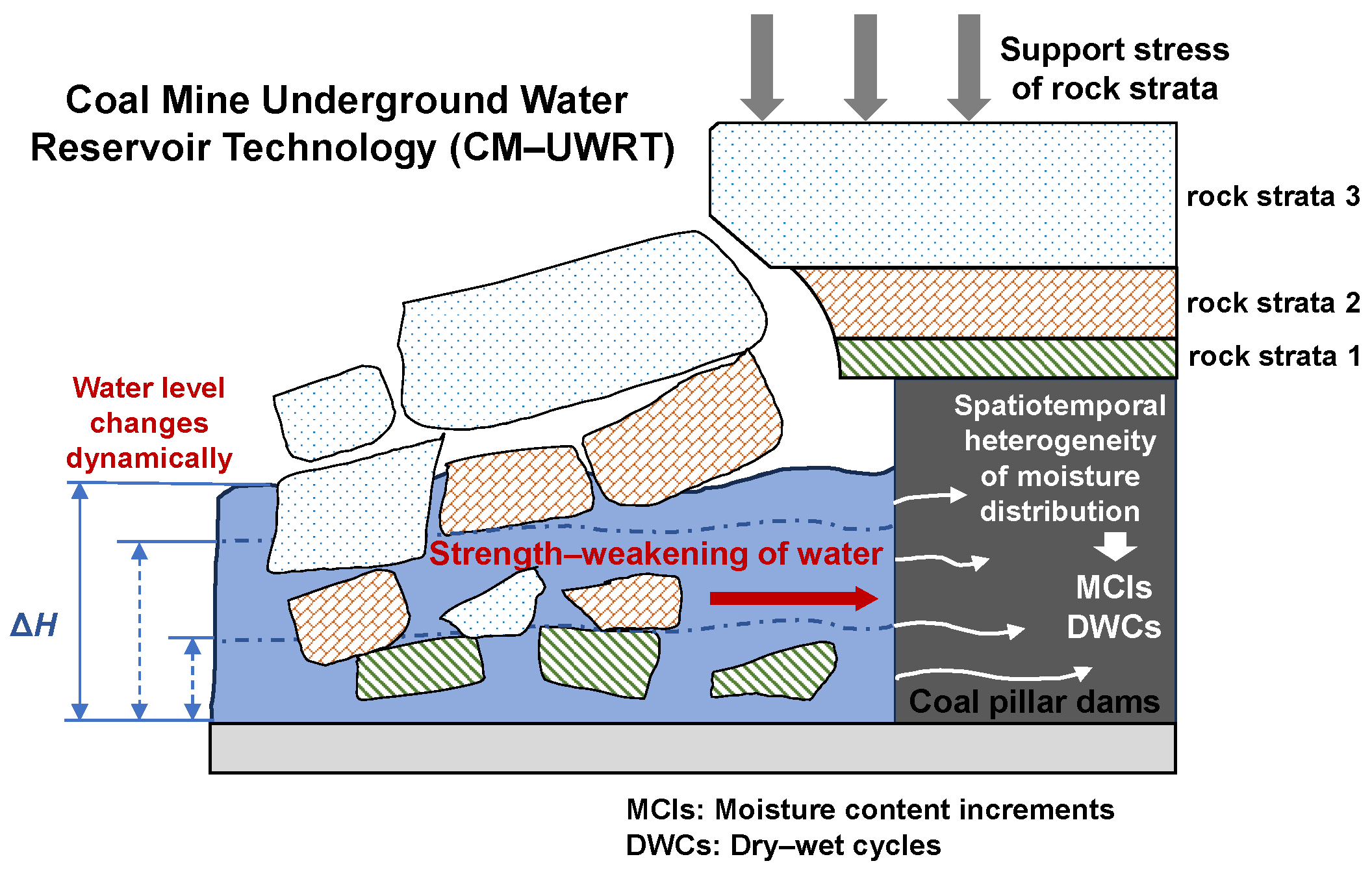
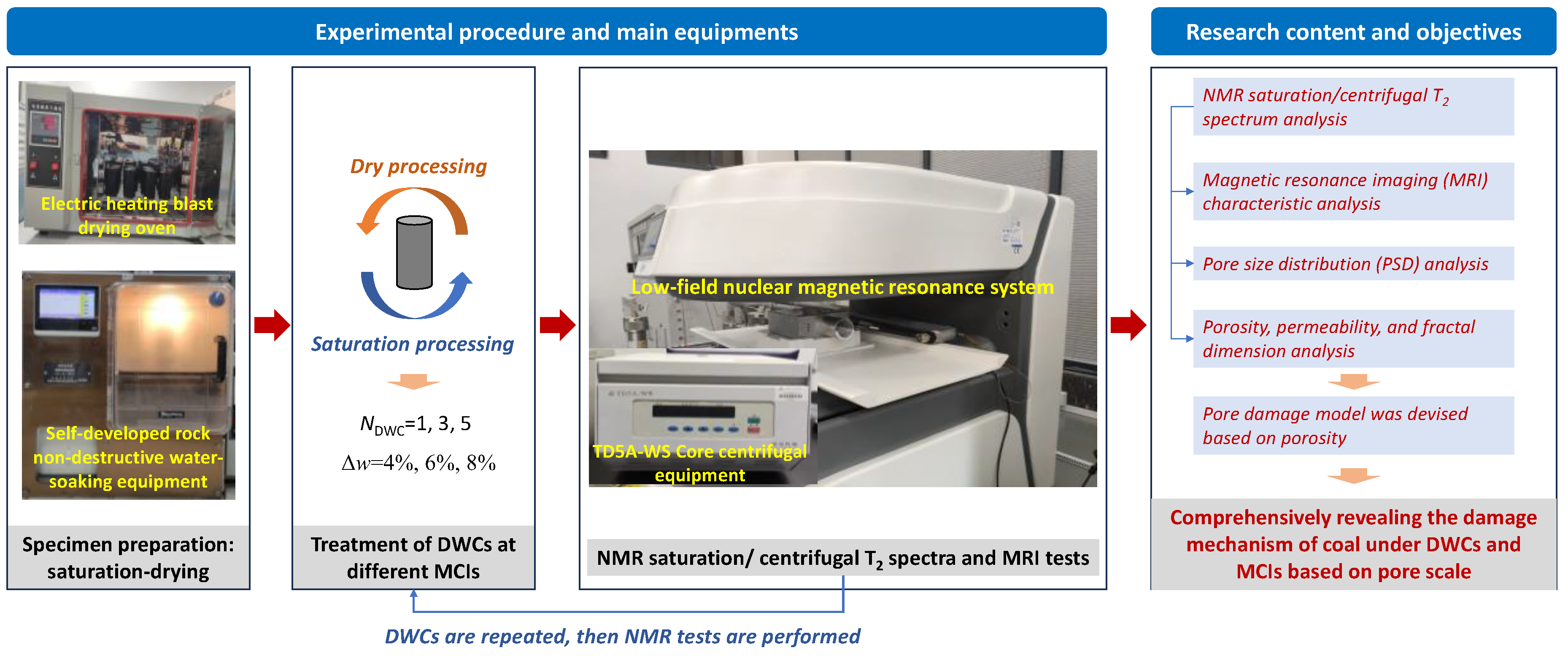
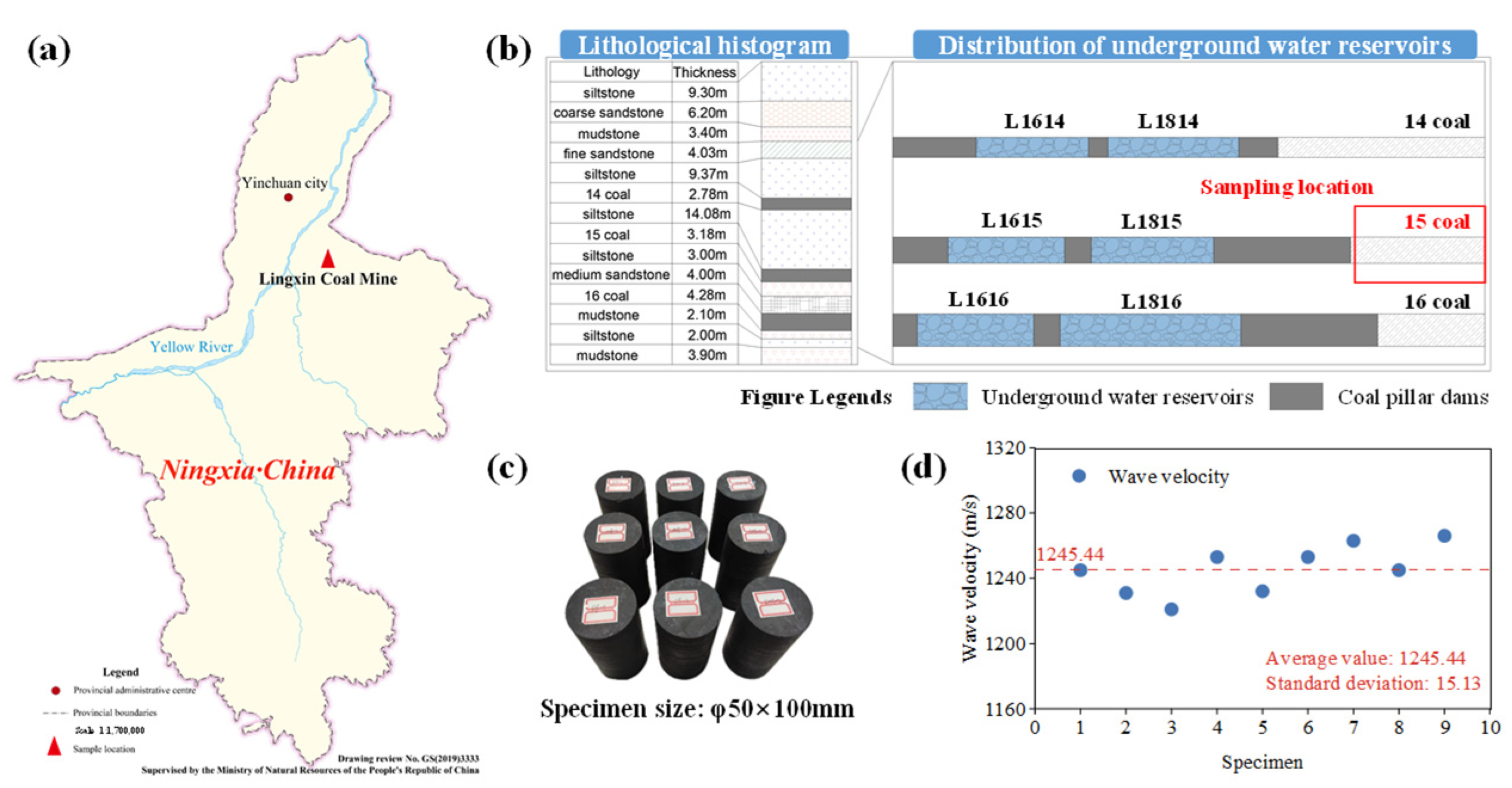
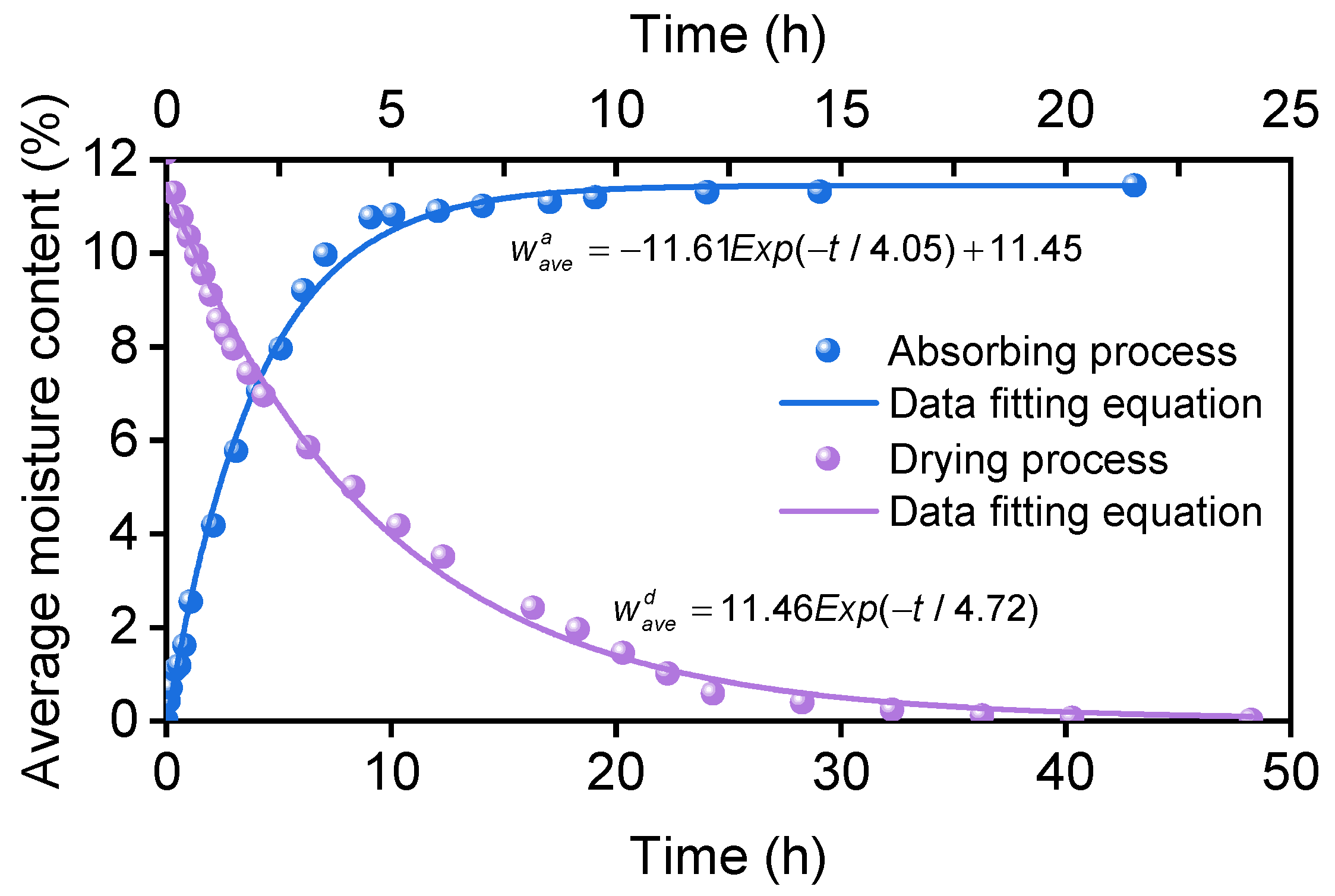
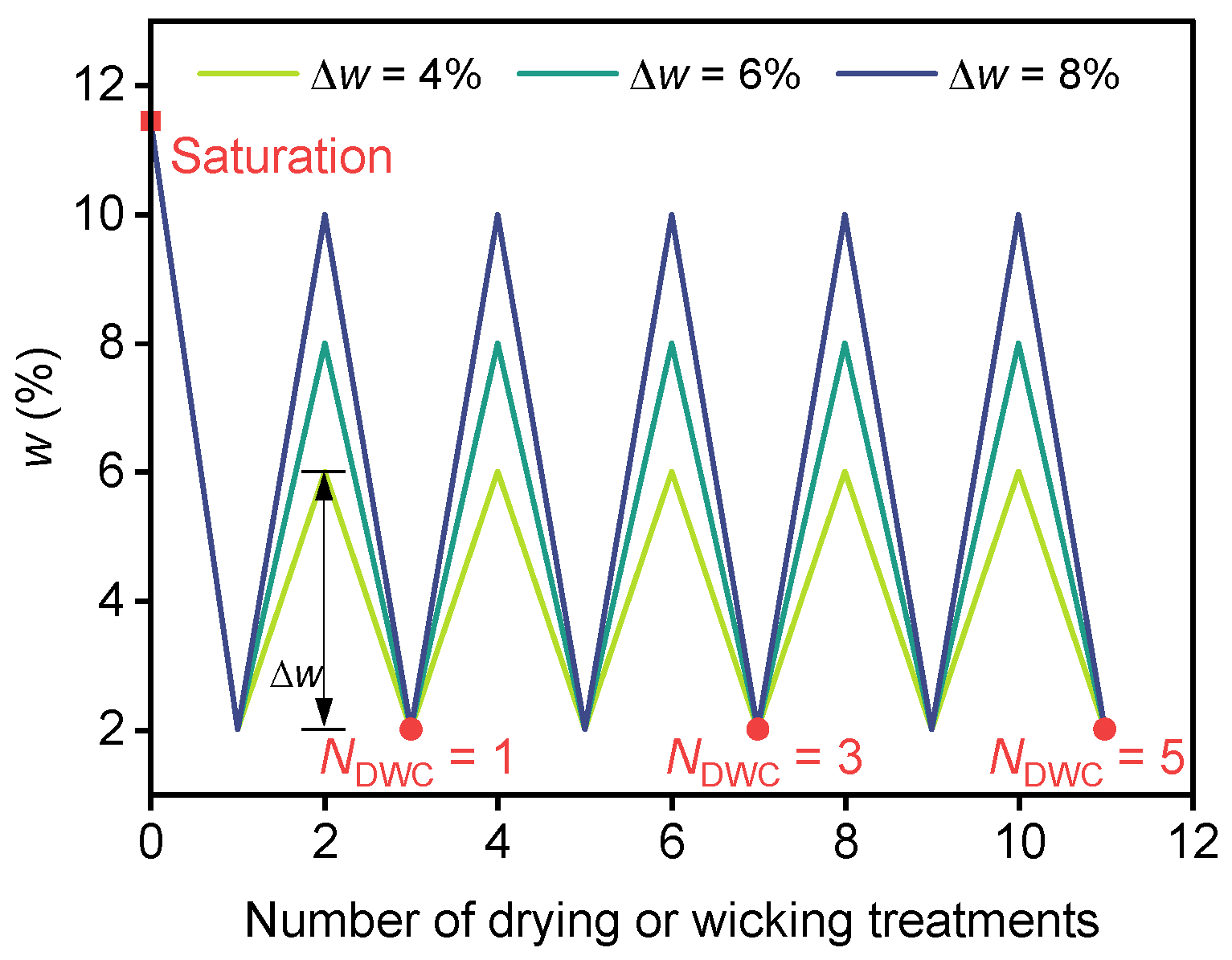
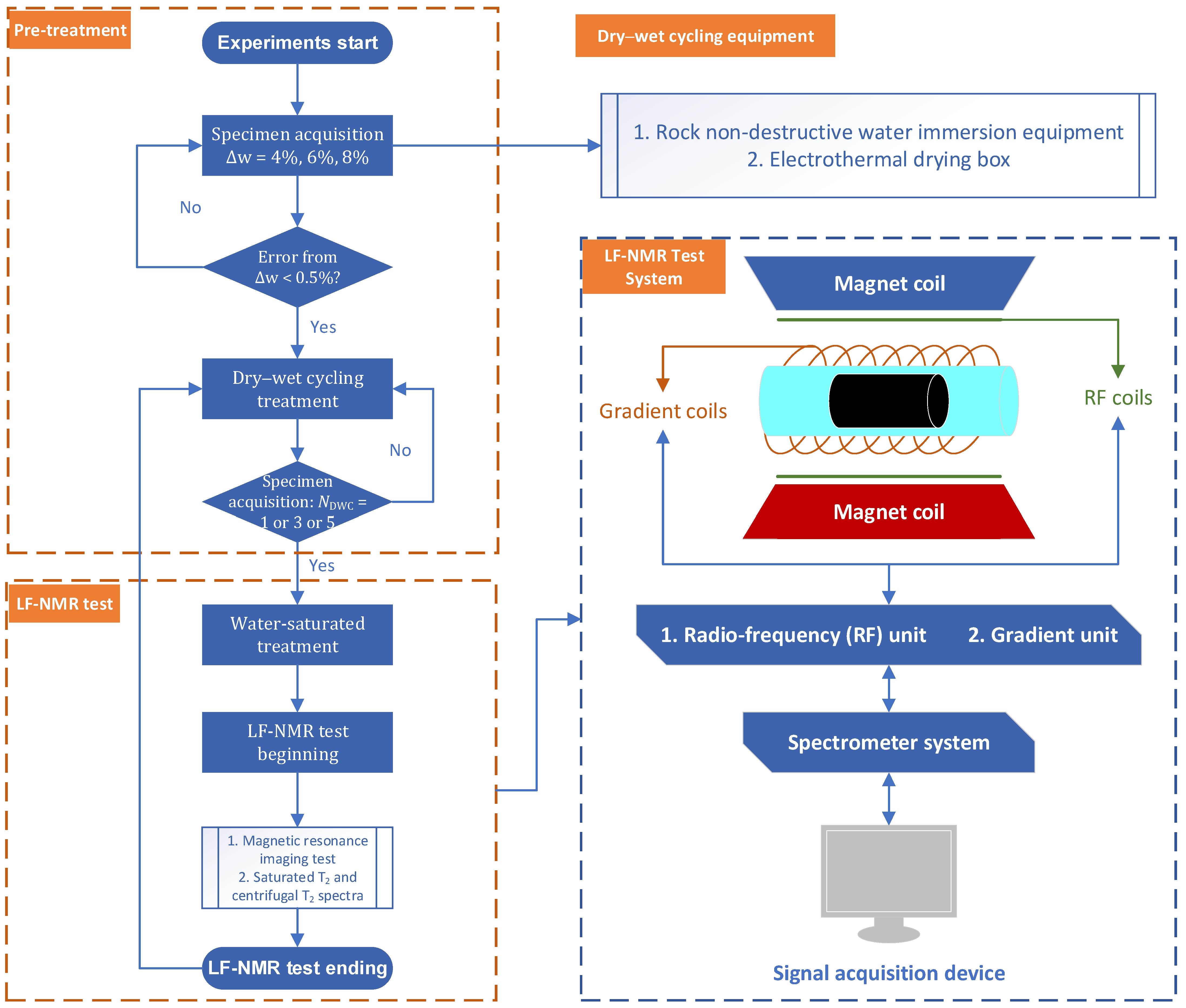
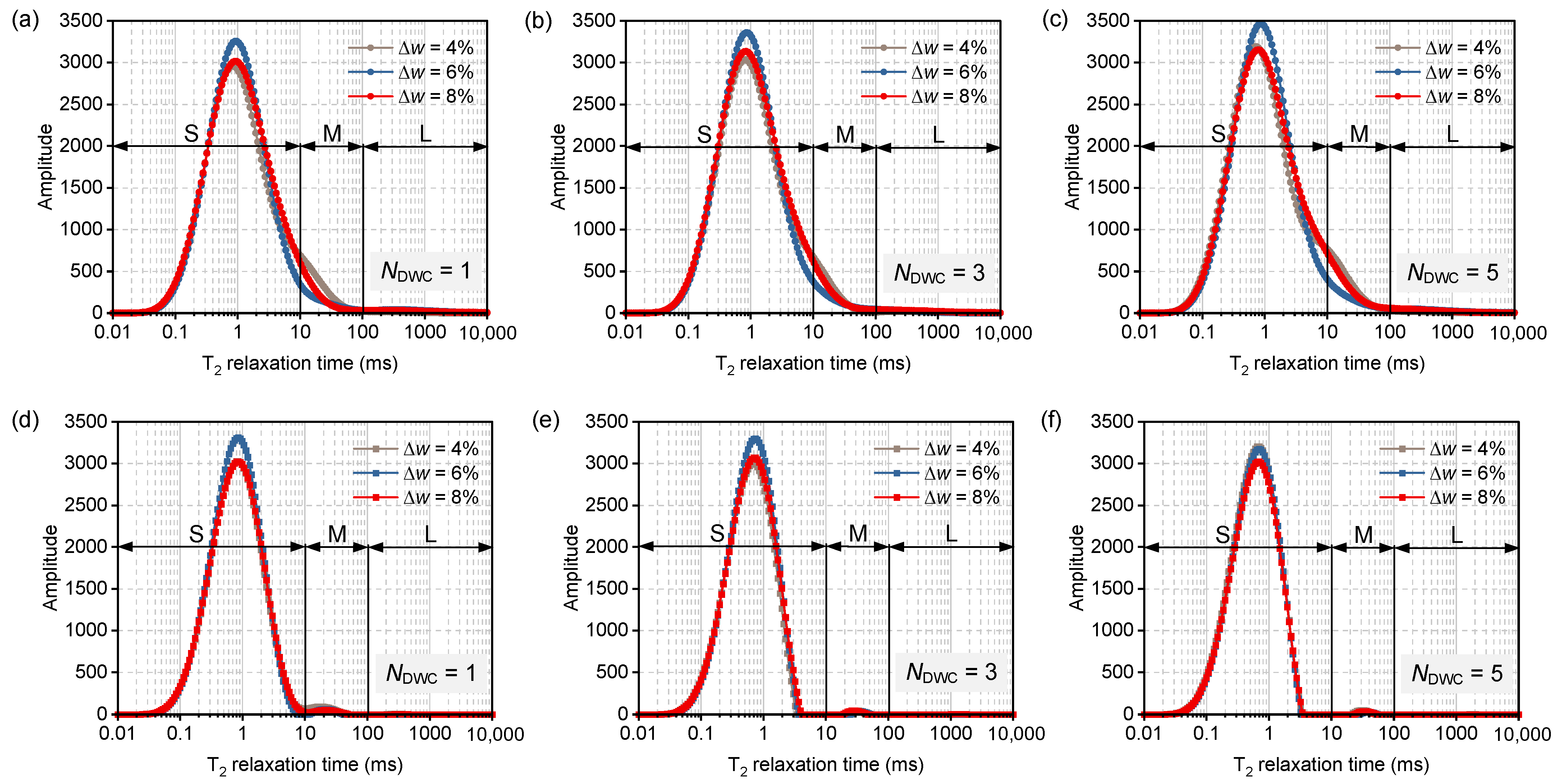







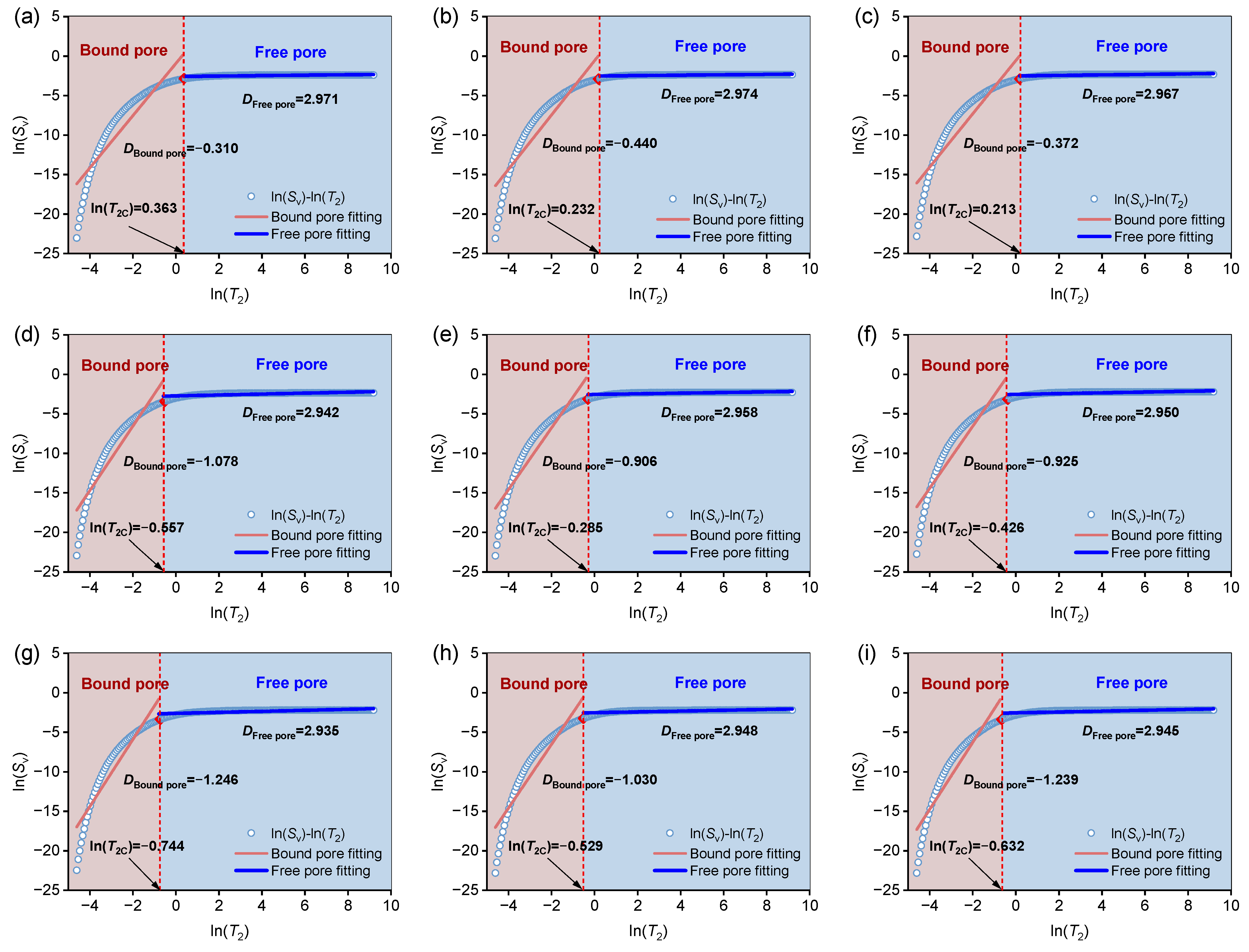
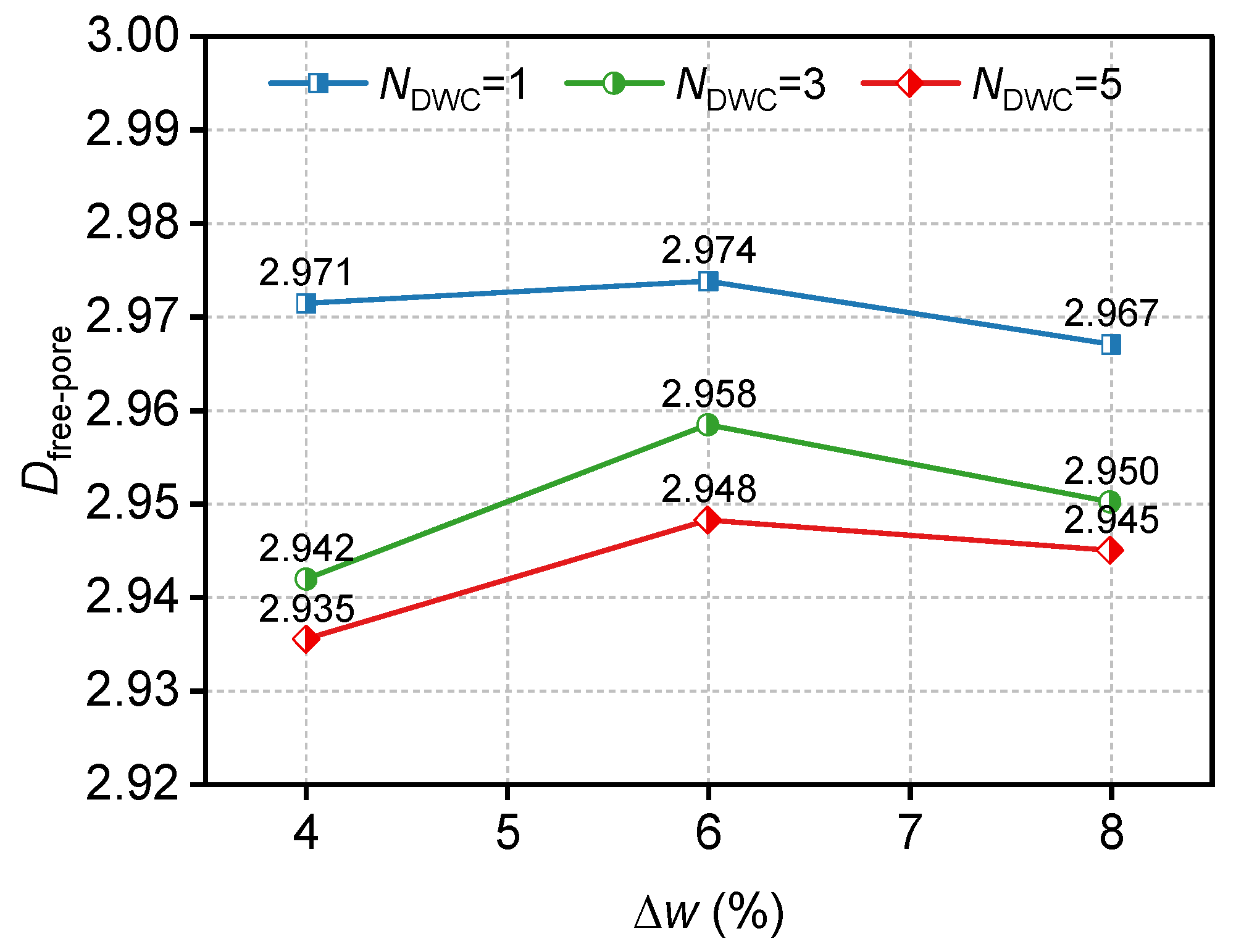

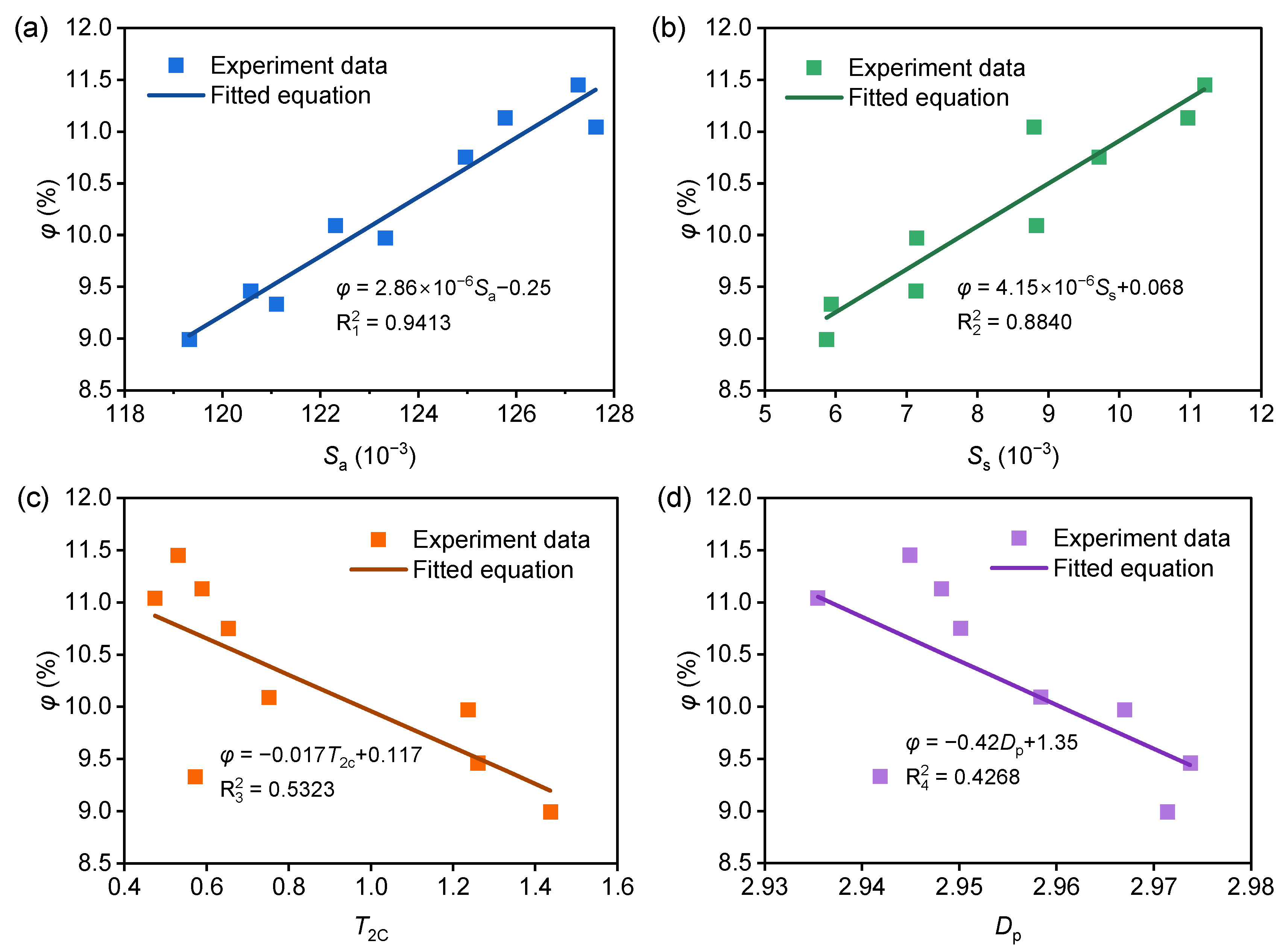
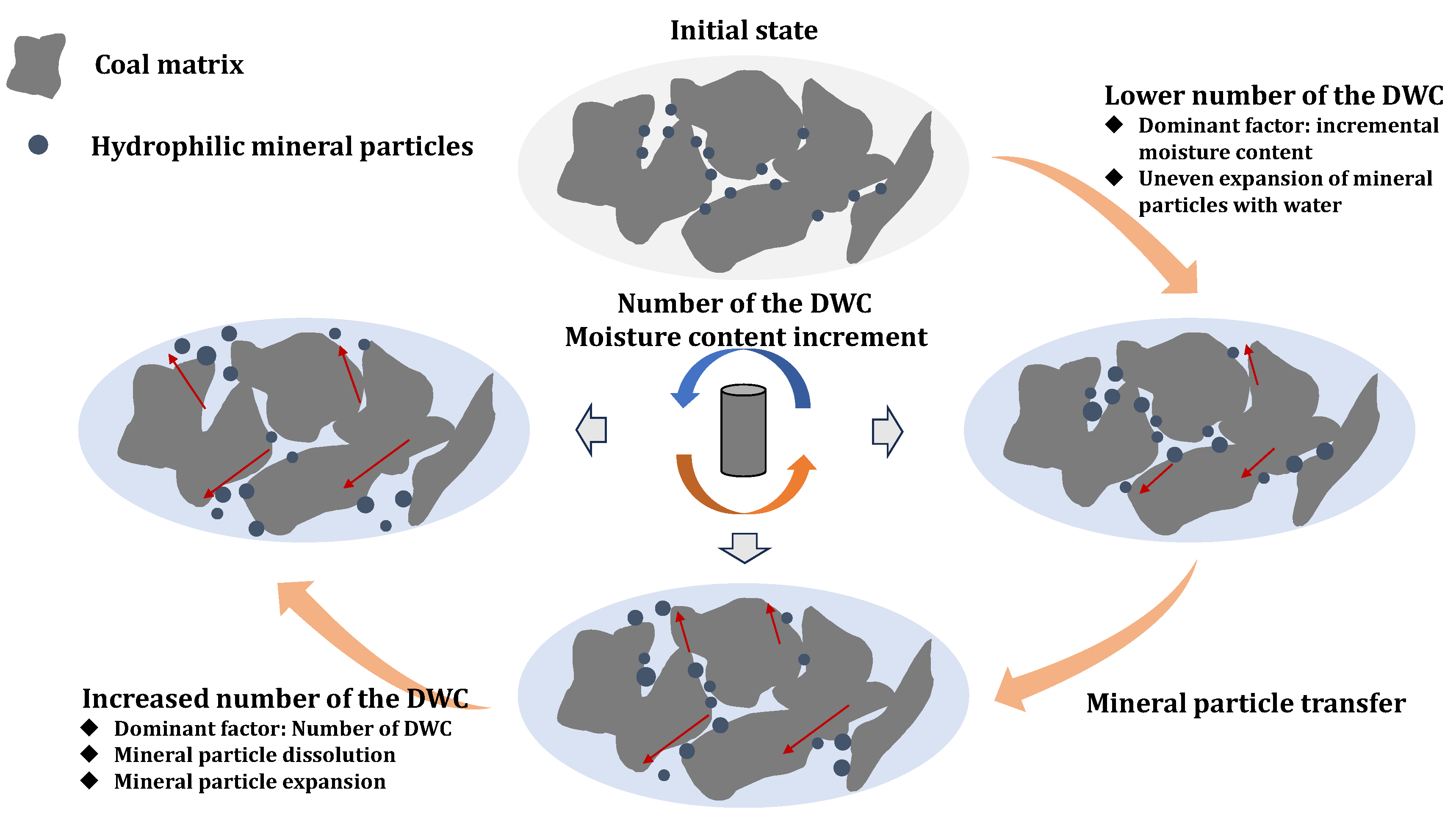
| Δw 1 (%) | Ta 2 (min) | Td 3 (min) |
|---|---|---|
| 1.95 | 50.02 | 494.39 |
| 4.17 | 107.81 | 298.09 |
| 5.94 | 183.77 | 183.26 |
| 8.30 | 294.88 | 101.79 |
| 10.03 | 505.51 | 38.59 |
| NDWC | Δw (%) | St | Sa | Ss |
|---|---|---|---|---|
| 1 | 4 | 125,198.17 | 119,325.57 | 5872.6 |
| 6 | 127,715.23 | 120,579.18 | 7136.05 | |
| 8 | 130,473.68 | 123,912.76 | 6560.92 | |
| 3 | 4 | 127,043.92 | 121,104.09 | 5939.83 |
| 6 | 131,143.32 | 122,311.08 | 8832.24 | |
| 8 | 134,679.37 | 127,566.52 | 7112.85 | |
| 5 | 4 | 136,434.08 | 127,634.07 | 8800.01 |
| 6 | 136,744.85 | 125,778.45 | 10,966.4 | |
| 8 | 138,469.96 | 128,965.45 | 9504.51 |
| NDWC | Δw (%) | U | μ | φ (%) |
|---|---|---|---|---|
| 0 | 4 | 125,508.06 | 639.53 | 9.05 |
| 6 | 127,246.37 | 648.39 | 9.37 | |
| 8 | 125,630.72 | 640.16 | 9.07 | |
| 1 | 4 | 125,198.17 | 637.95 | 8.99 |
| 6 | 127,715.23 | 650.78 | 9.46 | |
| 8 | 130,473.68 | 664.83 | 9.97 | |
| 3 | 4 | 127,043.92 | 647.35 | 9.33 |
| 6 | 131,143.32 | 668.24 | 10.09 | |
| 8 | 134,679.37 | 686.26 | 10.75 | |
| 5 | 4 | 136,434.08 | 695.21 | 11.04 |
| 6 | 136,744.85 | 696.79 | 11.13 | |
| 8 | 138,469.96 | 705.58 | 11.45 |
| NDWC | Δw (%) | (ms) | (ms) | kSDR′ (mD) |
|---|---|---|---|---|
| 1 | 4 | 1.174 | 0.786 | 0.0274 |
| 6 | 1.126 | 0.760 | 0.0256 | |
| 8 | 1.132 | 0.617 | 0.0248 | |
| 3 | 4 | 1.109 | 0.572 | 0.0237 |
| 6 | 1.133 | 0.609 | 0.0242 | |
| 8 | 1.172 | 0.564 | 0.0257 | |
| 5 | 4 | 1.071 | 0.604 | 0.0227 |
| 6 | 1.087 | 0.575 | 0.0230 | |
| 8 | 1.190 | 0.777 | 0.0279 |
Disclaimer/Publisher’s Note: The statements, opinions and data contained in all publications are solely those of the individual author(s) and contributor(s) and not of MDPI and/or the editor(s). MDPI and/or the editor(s) disclaim responsibility for any injury to people or property resulting from any ideas, methods, instructions or products referred to in the content. |
© 2025 by the authors. Licensee MDPI, Basel, Switzerland. This article is an open access article distributed under the terms and conditions of the Creative Commons Attribution (CC BY) license (https://creativecommons.org/licenses/by/4.0/).
Share and Cite
Xie, H.; Zhao, Y.; Qin, D.; Liu, H.; Xing, Y.; Cao, Z.; Zhang, Y.; Yu, L.; Zhang, Z. Pore Structure and Fractal Characteristics of Coal Rocks Under Variable Moisture Content Increment Cycles Using LF-NMR Techniques. Water 2025, 17, 1884. https://doi.org/10.3390/w17131884
Xie H, Zhao Y, Qin D, Liu H, Xing Y, Cao Z, Zhang Y, Yu L, Zhang Z. Pore Structure and Fractal Characteristics of Coal Rocks Under Variable Moisture Content Increment Cycles Using LF-NMR Techniques. Water. 2025; 17(13):1884. https://doi.org/10.3390/w17131884
Chicago/Turabian StyleXie, Hongxin, Yanpeng Zhao, Daoxia Qin, Hui Liu, Yaxin Xing, Zhiguo Cao, Yong Zhang, Liqiang Yu, and Zetian Zhang. 2025. "Pore Structure and Fractal Characteristics of Coal Rocks Under Variable Moisture Content Increment Cycles Using LF-NMR Techniques" Water 17, no. 13: 1884. https://doi.org/10.3390/w17131884
APA StyleXie, H., Zhao, Y., Qin, D., Liu, H., Xing, Y., Cao, Z., Zhang, Y., Yu, L., & Zhang, Z. (2025). Pore Structure and Fractal Characteristics of Coal Rocks Under Variable Moisture Content Increment Cycles Using LF-NMR Techniques. Water, 17(13), 1884. https://doi.org/10.3390/w17131884







